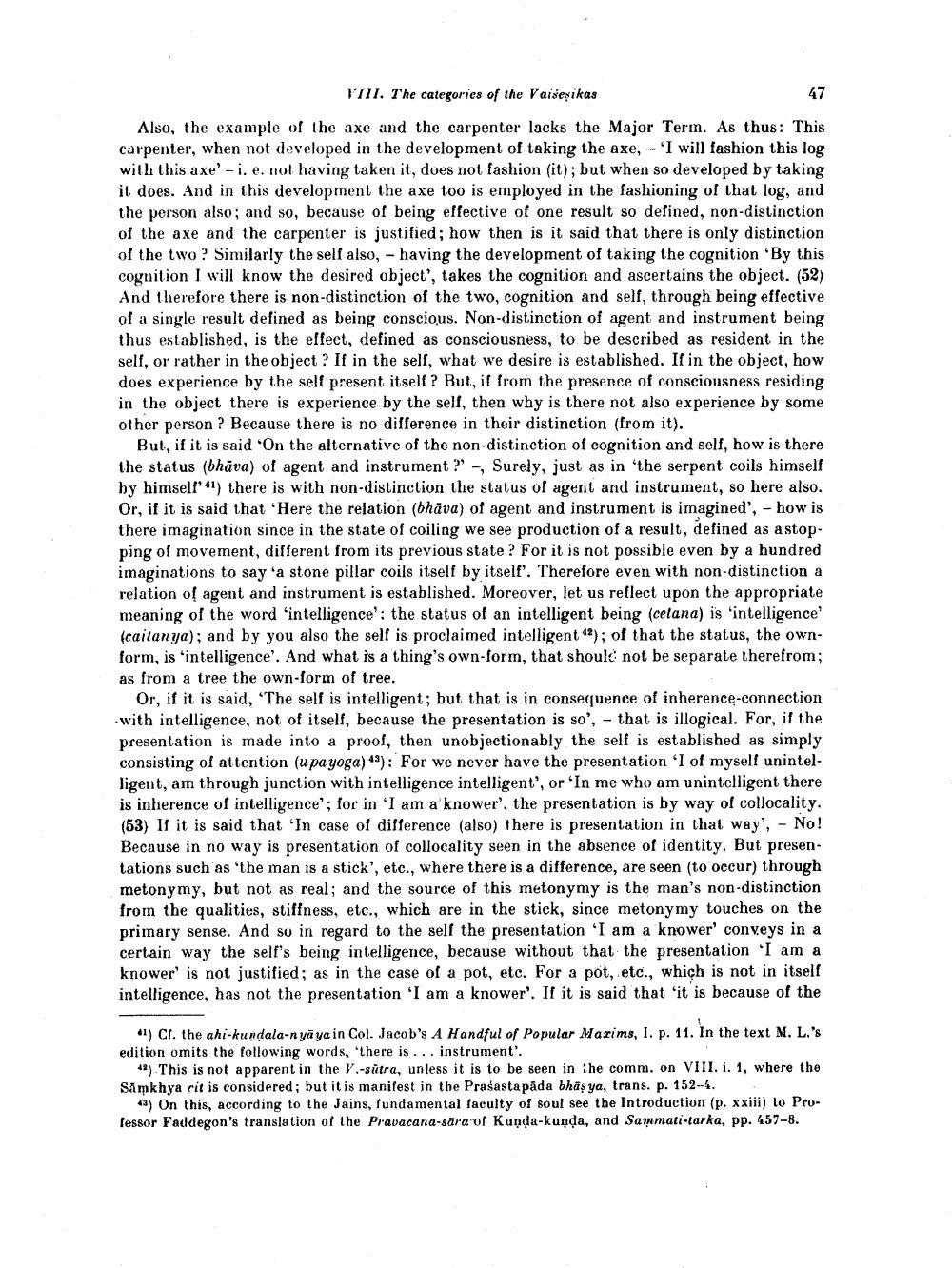________________
47
VIII. The categories of the Vaišeșikas Also, the example of the axe and the carpenter lacks the Major Term. As thus: This carpenter, when not developed in the development of taking the axe, - 'I will fashion this log with this axe'-i. e. not having taken it, does not fashion (it); but when so developed by taking it does. And in this development the axe too is employed in the fashioning of that log, and the person also; and so, because of being effective of one result so defined, non-distinction of the axe and the carpenter is justified; how then is it said that there is only distinction of the two ? Similarly the sell also, - having the development of taking the cognition "By this cognition I will know the desired object', takes the cognition and ascertains the object. (52) And therefore there is non-distinction of the two, cognition and self, through being effective of a single result defined as being conscious. Non-distinction of agent and instrument being thus established, is the effect, defined as consciousness, to be described as resident in the self, or rather in the object? If in the self, what we desire is established. If in the object, how does experience by the self present itself? But, if from the presence of consciousness residing in the object there is experience by the self, then why is there not also experience by some other person ? Because there is no difference in their distinction (from it).
But, if it is said 'On the alternative of the non-distinction of cognition and self, how is there the status (bhāva) of agent and instrument?' - Surely, just as in the serpent coils himself by himself' 41) there is with non-distinction the status of agent and instrument, so here also. Or, if it is said that 'Here the relation (bhāva) of agent and instrument is imagined', -how is there imagination since in the state of coiling we see production of a result, defined as a stopping of movement, different from its previous state? For it is not possible even by a hundred imaginations to say 'a stone pillar coils itself by itself'. Therefore even with non-distinction a relation of agent and instrument is established. Moreover, let us reflect upon the appropriate meaning of the word 'intelligence': the status of an intelligent being (celana) is 'intelligence fcaitanya); and by you also the self is proclaimed intelligent "); of that the status, the ownform, is 'intelligence'. And what is a thing's own-form, that should not be separate therefrom; as from a tree the own-form of tree.
Or, if it is said, 'The self is intelligent; but that is in consequence of inherence-connection with intelligence, not of itself, because the presentation is so', - that is illogical. For, if the presentation is made into a proof, then unobjectionably the self is established as simply consisting of attention (upa yoga) 43): For we never have the presentation 'I of myself unintelligent, am through junction with intelligence intelligent', or 'In me who am unintelligent there is inherence of intelligence'; for in 'I am a knower', the presentation is by way of collocality. (53) If it is said that 'In case of difference (also) there is presentation in that way', - No! Because in no way is presentation of collocality seen in the absence of identity. But presentations such as the man is a stick', etc., where there is a difference, are seen (to occur) through metonymy, but not as real; and the source of this metonymy is the man's non-distinction from the qualities, stiffness, etc., which are in the stick, since metonymy touches on the primary sense. And so in regard to the self the presentation 'I am a knower' conveys in a certain way the self's being intelligence, because without that the presentation 'I am a knower' is not justified; as in the case of a pot, etc. For a pot, etc., which is not in itself intelligence, has not the presentation 'I am a knower'. If it is said that it is because of the
") Cr. the ahi-kundala-n yāya in Col. Jacob's A Handful of Popular Marims, I. p. 11. In the text M. L.'s edition omits the following words, there is ... instrument'.
42) This is not apparent in the V.-sutra, unless it is to be seen in the comm. on VIII. i. 1, where the Samkhya cit is considered; but it is manifest in the Prasasta pāda bhäş ya, trans. p. 152-4.
3) On this, according to the Jains, fundamental faculty of soul see the Introduction (p. xxiii) to Professor Faddegon's translation of the Pravacana-sära of Kunda-kunda, and Sammati-tarka, pp. 457-8.




